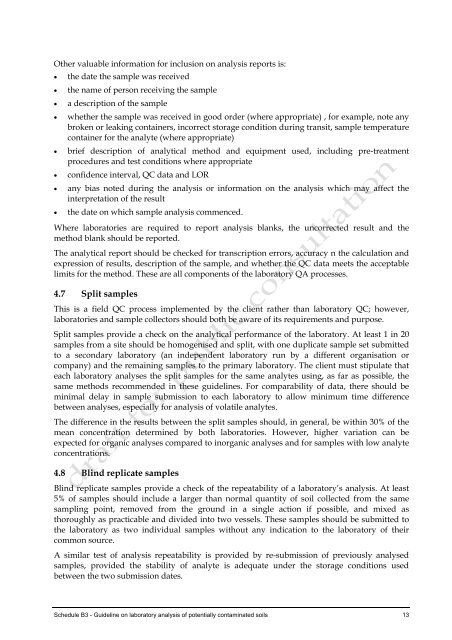Schedule B3 - COAG Standing Council on Environment and Water
Schedule B3 - COAG Standing Council on Environment and Water
Schedule B3 - COAG Standing Council on Environment and Water
- No tags were found...
You also want an ePaper? Increase the reach of your titles
YUMPU automatically turns print PDFs into web optimized ePapers that Google loves.
Other valuable informati<strong>on</strong> for inclusi<strong>on</strong> <strong>on</strong> analysis reports is:<br />
• the date the sample was received<br />
• the name of pers<strong>on</strong> receiving the sample<br />
• a descripti<strong>on</strong> of the sample<br />
• whether the sample was received in good order (where appropriate) , for example, note any<br />
broken or leaking c<strong>on</strong>tainers, incorrect storage c<strong>on</strong>diti<strong>on</strong> during transit, sample temperature<br />
c<strong>on</strong>tainer for the analyte (where appropriate)<br />
• brief descripti<strong>on</strong> of analytical method <strong>and</strong> equipment used, including pre-treatment<br />
procedures <strong>and</strong> test c<strong>on</strong>diti<strong>on</strong>s where appropriate<br />
• c<strong>on</strong>fidence interval, QC data <strong>and</strong> LOR<br />
• any bias noted during the analysis or informati<strong>on</strong> <strong>on</strong> the analysis which may affect the<br />
interpretati<strong>on</strong> of the result<br />
• the date <strong>on</strong> which sample analysis commenced.<br />
Where laboratories are required to report analysis blanks, the uncorrected result <strong>and</strong> the<br />
method blank should be reported.<br />
The analytical report should be checked for transcripti<strong>on</strong> errors, accuracy n the calculati<strong>on</strong> <strong>and</strong><br />
expressi<strong>on</strong> of results, descripti<strong>on</strong> of the sample, <strong>and</strong> whether the QC data meets the acceptable<br />
limits for the method. These are all comp<strong>on</strong>ents of the laboratory QA processes.<br />
4.7 Split samples<br />
This is a field QC process implemented by the client rather than laboratory QC; however,<br />
laboratories <strong>and</strong> sample collectors should both be aware of its requirements <strong>and</strong> purpose.<br />
Split samples provide a check <strong>on</strong> the analytical performance of the laboratory. At least 1 in 20<br />
samples from a site should be homogenised <strong>and</strong> split, with <strong>on</strong>e duplicate sample set submitted<br />
to a sec<strong>on</strong>dary laboratory (an independent laboratory run by a different organisati<strong>on</strong> or<br />
company) <strong>and</strong> the remaining samples to the primary laboratory. The client must stipulate that<br />
each laboratory analyses the split samples for the same analytes using, as far as possible, the<br />
same methods recommended in these guidelines. For comparability of data, there should be<br />
minimal delay in sample submissi<strong>on</strong> to each laboratory to allow minimum time difference<br />
between analyses, especially for analysis of volatile analytes.<br />
The difference in the results between the split samples should, in general, be within 30% of the<br />
mean c<strong>on</strong>centrati<strong>on</strong> determined by both laboratories. However, higher variati<strong>on</strong> can be<br />
expected for organic analyses compared to inorganic analyses <strong>and</strong> for samples with low analyte<br />
c<strong>on</strong>centrati<strong>on</strong>s.<br />
4.8 Blind replicate samples<br />
Blind replicate samples provide a check of the repeatability of a laboratory’s analysis. At least<br />
5% of samples should include a larger than normal quantity of soil collected from the same<br />
sampling point, removed from the ground in a single acti<strong>on</strong> if possible, <strong>and</strong> mixed as<br />
thoroughly as practicable <strong>and</strong> divided into two vessels. These samples should be submitted to<br />
the laboratory as two individual samples without any indicati<strong>on</strong> to the laboratory of their<br />
comm<strong>on</strong> source.<br />
A similar test of analysis repeatability is provided by re-submissi<strong>on</strong> of previously analysed<br />
samples, provided the stability of analyte is adequate under the storage c<strong>on</strong>diti<strong>on</strong>s used<br />
between the two submissi<strong>on</strong> dates.<br />
<str<strong>on</strong>g>Schedule</str<strong>on</strong>g> <str<strong>on</strong>g>B3</str<strong>on</strong>g> - Guideline <strong>on</strong> laboratory analysis of potentially c<strong>on</strong>taminated soils 13
















